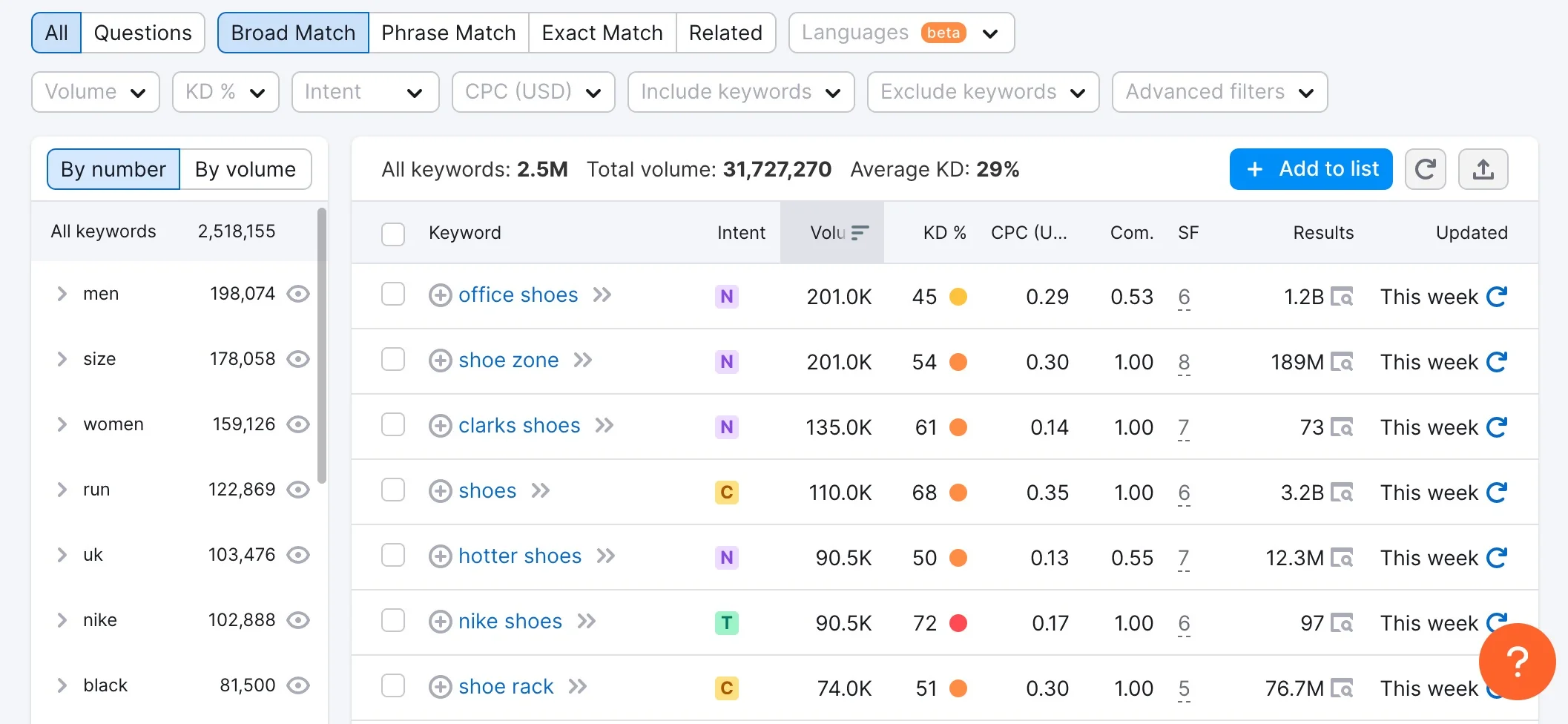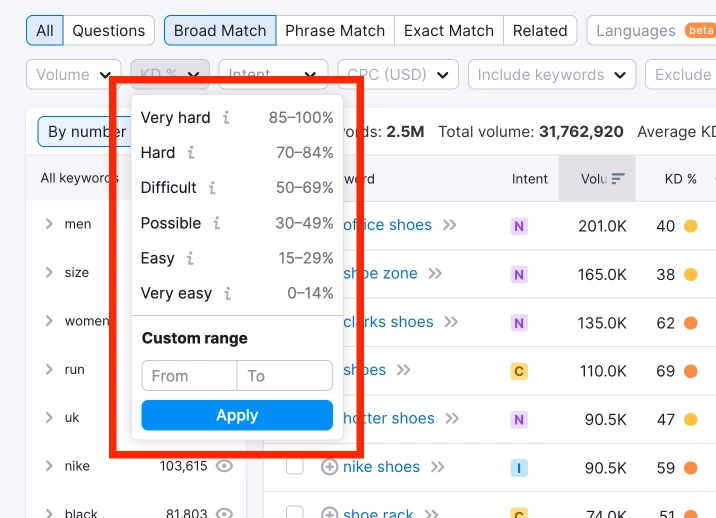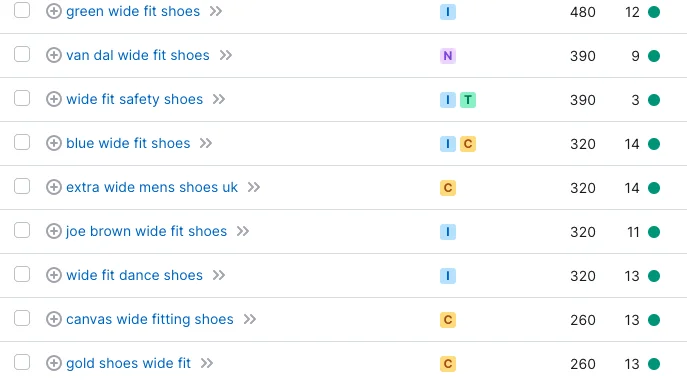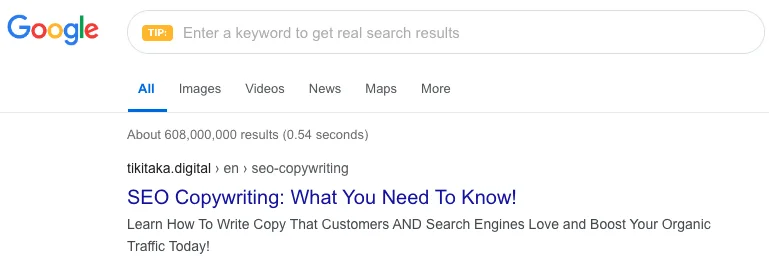SEO Copywriting: What you need to know
You’re probably here because you’ve been told that you need to do SEO Copywriting to help your business rank in Google, right? But what on earth IS SEO Copywriting, and how do you do it? Let’s get stuck in.
What is SEO?
SEO, or search engine optimisation, is the process of optimising (tweaking on and off-page content on your website) your online content to make it easily ‘discoverable’ by search engines, and thus, your target customers. The better the SEO, the more discoverable your site will be, and the greater the chance you’ll appear in those all-important page 1 or 2 search engine results. This work can be done by an SEO Consultant, an SEO agency, or if you have the time and knowledge, by you.
Whoever does it, the real magic of SEO and SEO Copywriting lies in the research and evaluation of the keywords and phrases that are relevant to your business and your target customers and the resulting creation of content which adds value to those customers (ideally something fresh too!). Read what Google has to say about ‘Creating helpful, reliable, people-first content’ here. How good your research phase is will determine how good your content is, and how good the organic traffic that it results in. We’ll get into the details of what this means in a bit.
As any good SEO Consultant will tell you, SEO comprises Technical and Content elements, so understanding the (at the very least) high-level technical landscape of your website’s digital presence is also fundamental to SEO success. Technical SEO can be complex and time-consuming, but for the small business owner, you might like to consider the following as being the most important. For those interested, click on the accordion, if not, skip to the next section.
Google has a free tool to help you establish if your site is mobile friendly (sometimes called ‘mobile responsive’ (in layman’s terms ‘Looks good on mobile’. Given that statistically, more people view sites on a mobile device than a desktop, if your site isn’t mobile responsive, drop everything else and fix this (Note: That might mean re-building your website. This is less scary and costly that it sounds, with basic websites costing less than €2,000. Give us a shout if you want to talk about this).
Use AHREFS free backlink checker to see if anyone is linking to your website and damaging it. If so, hunt those suckers down and disavow (stop their link from being reviewed/evaluated against your website by search engines)! Lucky for you, Google has a free tool to help you do this.
- Load your site in Google, right click, then hit ‘Inspect’
- Look at the top right of your screen. You will see ‘Elements’, ‘Console’, ‘Sources’ and ‘Network’ with two small >> icons, click that, then select ‘Lighthouse’
- Leave everything that is pre-selected, then click ‘Analyze page load’
- If your site shows a score of 90 or less for ‘Performance’, it will appear in amber. Follow this SEMRUSH guide to understand what your individual scores mean, then hit your Developer up for some help!
Ok, enough of the Technical stuff, let’s get back to SEO Copywriting!
Why should I care about SEO?
Hmmm let’s see. Got a website? Want customers for your product or service? Yes, you need SEO! The fact is, most (68%) online experiences still begin with a search engine, and unless you have your products on Amazon (where 50% of online purchases begin), you NEED to be on page 1, at the most the top of page 2 of Google to win any volume of new customers online. This means you need SEO; for the copywriting, Metadata (the words in the code + images + graphics of your website) and Technical performance of your website.
What is copywriting?
Copywriting is a critical component of your business’s marketing strategy – creating content that your target audience responds to, and that incites them to further engage with your brand is the Holy Grail of copywriting; SEO or otherwise. Be it Social Media posts, Email content, a LinkedIn post or words on your company website, content that engages your audiences and provides value to them is the very crux of what good copywriting is. Good copywriting takes the essence and heart of your brand and product or service and turns it into a story that’s so compelling for your target customer, they take an action and ultimately, become a customer.
SEO Copywriting in a nutshell
SEO copywriting means the creation of content that works for both search engines and human users; that is, copywriting that makes sense to, and engages, a human, and clearly appears as relevant content to Google.
SEO copywriting is not as simple as repetitively placing (in fact, you can get penalised for that! ) keywords into your content. It’s about creating high-quality, informative, and engaging content that also includes relevant keywords and phrases that people are searching for online. Write for humans, always, THEN do an SEO pass. Getting this balance right is complex and time-consuming. Depending on the hours you have to spare and your confidence levels, our SEO Consultants provide different packages aimed at offering you a full range of SEO Copywriting services; from workshops and 121 consultations to full retainer packages with content production included. Check out our SEO Packages to find out more.
To properly write SEO copy, you first need a deep understanding of your target audience, their needs, desires, the competitors of yours that they use and the keywords they are using to search for your product or service online. Gather all your business data, gather your team, read your online reviews, stalk your competitors and see how customers talk about your product or service (or that of your competitors if you are a new business!) online, then get to work searching for keywords! Mind Maps can be useful here to crystallise your proposition, and if you need to expand your content thinking, consider a tool such as Answer the Public, which visualises variations and themes for your ‘seed’ content topic or keyword – check out this example for ‘SEO Copywriting’!

If you need even more help, give us a shout. We have over 20 years’ experience in exactly this kind of stuff and can be engaged in many different ways to suit your business and budget.
SEO Copywriting: Keywords are King!
Spending time researching and thinking about the right keywords for your business and SEO copy is a fundamental skill for SEO copywriting and what sets copy that leads to traffic apart from copy that lives on your Blog that nobody sees. There are some good free tools out there to get you started; MOZ and SEMRUSH are our favourites. Our top tip is to start broadly and narrow down the list to the keywords that have a good volume, but are of the most relevance to your business. This is where the concept of keyword difficulty comes in. Hang tight, this is important!
Let’s look at the keyword ‘Shoes’ in the UK.

On the face of it, it looks like this is a good keyword to target, right? Wrong! Yes the volume is great, but the keyword difficulty is 68, meaning it will be extremely hard for your new website to rank on page 1 or 2. Should Google rank you above Nike, Clarks, Shoe Rack and other well-known shoe brands? NO, because the chances are that it is not the best search result for the user, and this is Google’s raison d’etre, and why they are the megagiant that they are.
How does Google know WHICH shoes you are offering, and which the users wants? Do you want office shoes, Nike shoes, boat shoes, house shoes (that one’s for my German friends)? The more specific you are, and the more you match your product offering to what people are searching for, the better.
Here’s a quick look at keyword difficulty percentages, and what it means for how easily your site will rank for said keywords:

Take the keyword ‘Nike shoes’ – almost impossible to rank for at 90% difficulty! Why? Well firstly, because the brand name is owned by Nike, then there are the thousands of official global resellers permitted by Nike to use their brand name, then there’s all the other major shoe retailers that also stock Nike, then there’s you, with your new website that Google knows nothing about.
So what DO you do? Well, you spend hours and hours (even days) researching what are called ‘long-tail keywords’. You think about them, Google them, you review competitor sites and a thesaurus, you look at other countries, you think deeply about your customer and their needs and desires; both obvious and not so obvious.
Long-tail keywords are, well, long. They usually have less competition than ‘Head’ or ‘Short-tail’ keywords and can help your website rank higher in search results by showing content to the user for more specific searches. Let’s look at some examples:


Sure, they might not equate to 200,000 searches a month, but if you stock these shoes, and write good content with optimised Metadata, you have a seriously good chance of ranking quickly on page 1 or 2, because the keyword difficulty (AKA competition) is low! Do that ten times and you then have thousands of clicks to your website, and start to see the knock on effect into sales.
Writing SEO copy
First things first, remember our golden rule is to write content that provides value to users. Maybe you are an authority on ‘wide fit dance shoes’, if you’re not, make yourself! Link to other sources on the subject, quote experts on the topic, write deeply and informatively about the subject in a way that leaves the reader understanding what it is you are talking about! Look at this article for example. If by this point you have a pretty good idea of what SEO copywriting is, I have done my job!
Secondly, find the right keywords and use them naturally in the text. Don’t stuff them in willy nilly; your reader will see it, and so will Google! DON’T be tempted to cut corners and use AI, again, it’s obvious to the search engines, and a boring read for the user – talk like a human, not a computer!!
In addition to using keywords properly, it’s also important to understand and correctly use meta tags, descriptions and header tags. These elements signal to search engines what your content is about and need to thus contain relevant keywords and phrases. This article by Google explains what Metadata is, why it’s important and how to craft good examples of them. Think of your Metadata like a shop window in the Google SERP (search engine results page) – whether someone clicks it or not (which, over time signals positively to Google and improves your rankings, as well as directly results in traffic to your site!) means whether they ‘walk into’ your shop or not. Here is a brilliant example of Metadata, if we do say so ourselves:

A well-written meta description entices users to click through to your website from search results. It is clearly written (yes, capitalise the first letter of each word; weird, but it works!), it clearly communicates what the content is about and it has a call to action. Header tags break up your content and make it easier to read for the user and the search engines.
The most important thing to take from this blog post, is that the key to successful SEO copywriting is to create content that engages and provides value to your target audience. So how do you do that?!
Content isn’t King, engagement is!
I’ve lost count of the amount of businesses I’ve seen haemorrhaging marketing budget on visually beautiful Social Media content that drives zero engagement and thus does absolute zip for the brand. Why does this happen? Because the brand is thinking from the perspective of the brand and product and NOT the consumer.
If you are a vegan FMCG food product, don’t waste your time extolling the virtues of veganism! Snore! We KNOW that, as do the people who have interrupted their stupidly busy day to look at your Instagram content. Think about them, and not what you want to say, promote, communicate – what does your product do for them? For example, say you can save someone 15 minutes a day cooking, what’s that in a year? Over 90 hours, or 7 waking days! So do a feature on awesome things to do in 7 days, do a feature on the best countries to visit if you have 7 days, go out on the street and interview people and ask what they would do if they gained a free week to do whatever they wanted! THAT is what engages people. It still links to your product, it still promotes your brand, but it does it on human terms, not business ones.
It is essential to understand your customer deeply; this knowledge will help you create content that is both informative, engaging and value-adding. For more content marketing insights or help, give us a shout to see if we can help inspire you and your business.
Another trick for SEO copywriting is to use storytelling to bring your brand to life and connect with your customers emotionally. Emotions create a sense of urgency and motivation. They create actions and behaviours, and this is what we want from our potential customers. Customer testimonials and bios help illustrate how your product or service has helped real people – this engages and builds trust.
One final crucial element in successful SEO copywriting is the use of visuals and non-copy content such as graphics, videos, audio snippets. Content such as this creates engagement and increases dwell time, as well as reducing bounce (someone who comes to your site and leaves after seeing a single piece of content) – these are key signals to Google that also impact search engine rankings. It doesn’t have to be Steven Spielberg quality production – one quick look at Instagram or TikTok will tell you that. Produce content from the heart, with your customer in mind, and it will be well-received.
So dear reader, if you got this far and still don’t feel able to go it alone, check out our SEO Packages page, or contact us for a free consultation. We can do in-person meetings in the UK, Spain or Germany and video consultations everywhere else.
We form long-term partnerships.
Over 90% of our customers continue their partnership with us in year 2 of their campaign.
